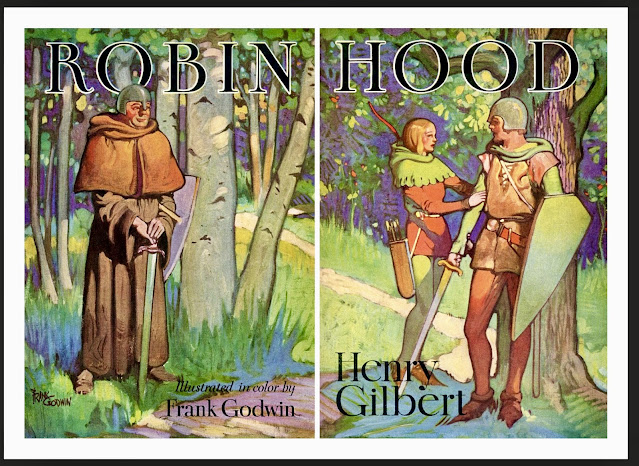May 1934 American Boy Magazine cover
Artist: William Soare
“Underneath this little stone
Lies Robert, Earl of Huntington;
No other archer was so good -
And people called him Robin Hood.
Such outlaws as he and his men
Will England never see again.”
- ‘The Adventures of Robin Hood’
By Roger Lancelyn Green
British biographer & children’s writer
Robin and the Men of Sherwood
Artist: Greg Hildebrandt
Robyn Hode
Robert Hood
Robin of Sherwood
Robert Fitz
1897 Robinson Crusoe series book by the McLoughlin Bros.
Well, before we can learn about this ‘Robin Hood’
shouldn’t we at least know what was his actual name?
Through the centuries
(Yes, centuries!)
he has been called many names -
Robertus Hod
Robin of Loxley
Robert Huntingdon
Robyn Hude
1939 edition by E. Charles Vivian
Artist Harry G. Theaker
Robin de Courtenay
Sir Robert Hode
Robert Hod
Robehod
1952 movie ad for Walt Disney’s
‘The Story of Robin Hood and his Merrie Men’
Was there a specific person from history that the Robin Hood adventures are based on?
No one really knows. What we do know is that the stories about Robin and Marion have endured for ages. So perhaps there was one man that started it all, but like a snowball rolling downhill, it has gathered a lot of extra weight and fluff!
Poster for 1922 silent movie “Robin Hood”
We can’t go much further without a little
Roman Catholic Church history.
In the 12th, 13th century the Catholic Church was
The Authority - on everything. What you ate, wore, who you could marry, and where you lived was all dictated by the Church.
Most peasants were too busy trying to survive than indulge in luxuries such as reading, hygiene or hobbies.
Church authorities recognized that all work and no play made Common Man a very dull and restless subject.
And so we have Festival & Feast Days.
These were a spill-over from ancient times when different religious groups (think Celts) had special days to celebrate changes in seasons and other vital events (think fertility to produce next generations).
There was little to no reliable written languages for the Common People, and they had no time to learn it anyway, so The Church stepped in.
They ordained special days (many coinciding with pagan rituals) to provide a break from drudgery and routine.
It also put the focus back on religion rather than tribal customs, and became an important way to teach the people religious teachings.
For instance, it was this time period that the Nativity Plays became popular in teaching about Christ’s birth.
So where is Robin Hood?
Artist: N.C. Wyeth
As far back as 1261 there are hints, suggestions & notes in manuscripts about a Robin Hood type character.
Many with Maid Marion!
In 1280 there were French ballads and plays about ‘Robin & Marion’ that were featured in May festivals.
Artist: Lucy Fitch Perkins, 1923
Or was it Lady Marian?
Oh, let’s not go there!
By the 15th century the ballads had moved from
‘for nobility only eyes’ & street recitals
to scripted plays with set tunes.
The earliest preserved script is from 1450!
Author/Illustrator Louis Rhead, 1912 woodcut
William Shakespeare mentions Robin in a few of his plays. (1564 - 1616)
In 1795 Joseph Ritson wrote about Robin Hood and his Merry Men.
In 1818 Ritson’s friend Sir Walter Scott used his anthology of Robin Hood in his famous novel “Ivanhoe”.
‘The Merry Adventures of Robin Hood, of Great Renown in Nottinghamshire’
Written and illustrated by Howard Pyle, 1883
The stories and adventures of Robin Hood, Marian and the Merry Men have been around a long time; changing, evolving and reshaped as current events did the same.
In the earliest Robin Hood documents Robin is violent and murders those who have betrayed him. There are even hints at a possible romantic link-up with the Sheriff’s wife!
Movie poster for ‘The Adventures of Robin Hood’ 1938
Times were cruel and unjust to most.
People had a lot of repressed anger.
Robin’s stories and ballads reflected this.
In 14th century England the common people were becoming more and more unhappy with the feudal system and a life of servitude.
Robin Hood appears as an anti-establishment hero. He uses his wits and charisma to make fools of those corrupt authorities.
Movie poster for ‘Walt Disney’s Robin Hood’, 1973 Artist: Dave Perillo
“We never rob.
We just sort of borrow a bit from those who can afford it.”
-Robin Hood, Disney animated movie
Later, Robin Hood becomes a dispossessed aristocrat with a heart of gold and true love for Maid Marian.
‘The Adventures of Robin Hood’
1938
So…
which is it?
Saint or Sinner?
Artist: Walter Crane (1845 - 1915)
I guess we each have to decide that on our own!
I think he was both,
adapting to the desires and needs of the people around him. His stories are constantly changing with what they emphasize just as life is always changing.
Outlaw?
Yes. He broke the current laws of the times.
Hero?
Yes. He came to the help of people in dire need.
Can we have both?
1932
In researching for this blog I found so many wonderful paintings, woodcuts, illustrations and more all with a Robin Hood theme.
I’m sure I will be sharing more of these in the very near future!
That’s all for now!
‘Til next time,
inkspired
Here are some of the sites I researched while making this blog.
In no particular order:
azquotes.com
goodreads.com
moviemistakes.com
en.Wikipedia.org
History.com
Pinterest
rarebooks.ie
wikimedia
Encyclopedia Britannica
Possibly from “Life and Adventures of Robin Hood”
Written by John B. Marsh; 1880
Artist: unknown
















No comments:
Post a Comment